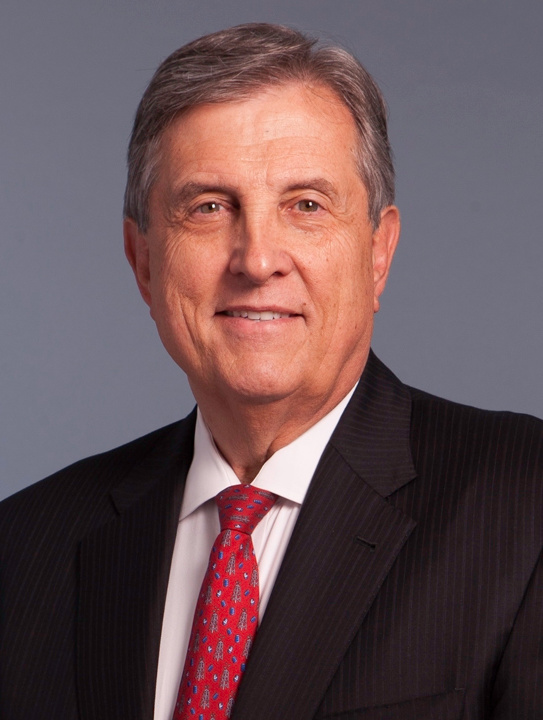Presented by:
[Editor's note: A version of this story appears in the May 2021 issue of Oil and Gas Investor magazine. Subscribe to the magazine here.]
Marathon Oil Corp.’s press release announcement in late January was anything but ordinary. The Houston-based oil and gas producer wanted the world to know that, beginning in 2021, it was retooling the fundamental structure for how its executives would be paid going forward. First and foremost, production and growth metrics—the golden bonus-award ring for E&P management for decades—cease to exist on the compensation scorecard. The new priority: long-term shareholder value.

“We believe strong corporate governance is foundational to delivering ultimate shareholder value and have modified our executive compensation framework to further align management interests with stakeholders and to incentivize the behaviors we believe are most important,” said Marathon chairman, president and CEO Lee Tillman in the release.
Marathon joins a growing number of public E&Ps not only promising capital discipline in the face of investor exodus, but also restructuring executive compensation plans to incentivize these changing business models into an improving commodity price environment.
Yet, asking the oil and gas sector to change longstanding executive pay bonuses is akin to asking Congress to instate term limits: laughable without a grassroots uprising. But the upstream E&P space burned $342 billion in negative cash flows from 2010 through 2020, according to a Deloitte report, and during that same period the XOP Index of exploration and production companies trailed the S&P 500 by 225%, achieving an unremarkable 40% negative return.
And despite being one of the worst-performing sectors during the past decade, E&P executive compensation continued to rise. According to a 2019 PwC study, it’s one of the highest paying sectors in the U.S. with one of the lowest termination rates.
That uprising came in the form of investors fleeing for the exits.
“The fundamental problem was the lack of alignment with shareholders,” said Mark Viviano, managing partner and lead portfolio manager on the public investment team with New York investment firm Kimmeridge Energy Management Co. “It began with skewed incentives and low insider ownership, and it was compounded by boards that were unwilling to hold these management teams accountable. These management teams are willing to take risks because there’s no downside to underperformance.”
Said one E&P CEO who spoke on condition of anonymity, “Short-term bonuses are too easy to attain and long-term bonuses are too high and not aligned with shareholder interest, so you have teams that make an enormous amount of money when shareholders are not. They want to be aligned [with management], and they’re happy to compensate very well as long as they do well.”
So how can executives woo investors back to their companies’ equities? Simple: They must drastically change the way they’re paid.
For growth’s sake
“This is all a reaction to CEOs that got super wealthy despite share prices getting cut,” said an E&P board member who spoke on condition of anonymity.

Cowen Inc. sell-side analyst and managing director David Deckelbaum said the issue between investors and E&P management incentives has been festering for some time. “The general narrative with most investors that look at E&P is that there is no capital restraint and that management is not properly incentivized to pursue things that have sustainable return profiles.”
Executive ownership of company equity perpetually screens low within the E&P sector, he said, and an inordinate weighting toward growth has led to mistimed cycles and consistent value destruction.
That lack of capital constraint derives from executives being incentivized via compensation structures to grow production and reserves. Historically, production growth has been the plum line for measuring an independent’s success and in a world of resource scarcity that made sense. The rise of shale gas and oil, however, created a global oversupply. Combined with the energy transition movement to shift to more renewable fuel sources, putting future demand in question, chasing more resource became less desirable to investors.
“The discovery phase of resources is over,” said Deckelbaum, based in New York. “Now it’s a matter of how you most optimally harvest these assets for the benefit of all shareholders. It’s a mature phase designed to increase returns of capital to shareholders instead of looking for future growth.”
No one believes that more fervently than Viviano, whose firm has equity investments in Ovintiv Inc., PDC Energy Inc. and Cimarex Energy Co. Any correlation between growth and shareholder value creation no longer exists, he insists.
“Solving for production growth instead of free-cash-flow generation just breaks down the correlation with shareholder value creation. The idea that everybody needs to maintain or grow production as a starting point has simply resulted in the destruction of value for the sector, and so what we do know is that model doesn’t work.”
The average U.S. E&P reinvested 130% of cash flow during the past 10 years, Viviano reminded, “and that’s obviously not a sustainable business model for any industry. It resonates with us that if you’re spending more than 100% of your cash flow in a business that cannot cover its cost of capital, it’s going to destroy value.
“There’s no other industry where management teams would continue to see a rise in compensation as that value is destroyed.”
Yet production still dominates E&P executive compensation incentive plans. According to a mid-2020 E&P executive compensation report by Alvarez & Marsal, more than 80% of independent producers continue to reward executives based on growth metrics.
Sidebar:
BUILDING PRIVATE EQUITIES
Private companies are not exempt from executive comp retooling, said The Carnrite Group’s CEO and president, Al Carnrite. Limited partners backing private equity portfolio companies are just as attuned to the issues of returns and ESG as are other investor groups.
“I can tell you the private equity groups we deal with—and we deal with some of the biggest in the world—all have a similar expectation of what they would have as a public company. There are some companies out there on the private side that appear to be drilling beyond their cash flow, but it’s a small universe.”
He said he is not aware of any private equity-sponsored company that has not relooked at the executive compensation program for their portfolio companies, with cash flow and ESG being brought into the formula, and production becoming a smaller component.
“Those are all major changes like you’re seeing on the public side. Their challenge is who do you benchmark to, and what does success look like? But if you believe the private market is there to compete with the public market, then the benchmark is pretty clear: You’ve got to be as good as the public companies or better.”
Within the private equity models, the traditional waterfall payout structure no longer drives private executive compensation, he said. Instead, management teams are being incentivized to earn equity based on performance. “Nobody’s building these things to flip anymore.”
Ten-year pools of capital are being raised with the incentive to grow cash flow and pay out to investors through dividends. Management that succeeds in doing that will build their rewards through options, or a similar currency. “Call it anything you want, but it’s going to behave like equity,” said Carnrite.
Not everyone, however, believes that growth by E&Ps should be vilified, either in the past or present.
Al Carnrite, president and CEO of Houston management consulting firm The Carnrite Group, is quick to defend the industry’s rationale for growth-based incentives historically. “Incentives were driven by what Wall Street was rewarding; it wasn’t done in a vacuum.”

The growth model was justifiable in a growing commodity price environment, Carnrite noted, and Wall Street was content with pay structures then, but as soon as the market turned distressed after 2014, the growth model “totally fell apart,” he said, and “we just destroyed hundreds of billions of dollars of capital in the shale plays.”
Presently, there is no doubt Wall Street’s expectations have changed dramatically because of the capital destroyed by the industry, he said, “but I don’t think we woke up one day and said, ‘Let’s create some metrics to drive executive comp and get rich at the expense of the shareholder.’ The people with the dollars make the rules.”
Likewise, David Preng, president and CEO of Houston executive search firm Preng & Associates, countered that all companies across all sectors are trying to grow and get better, he said, whether manufacturing, food, pharmaceuticals or chemicals.
“Everyone’s trying to grow, and there’s no reason that an oil company can’t grow. But you have to look at how you grow, and that growth has to be done in a way that creates shareholder value. It’s not just growth for growth’s sake.”
Growth could be measured in increasing reserves, he said, but it must be done at the right price to create value. “You’ve got to be returning your cost of capital or you’re dying.”

But when restructuring executive compensation plans, he urged, “Don’t throw out the baby with the bathwater. You need growth that will return capital—and compensation plans that drive that.”
Viviano added, “We’re not against growth, but solving for growth has been the fundamental problem of this industry. There are different ways of creating value, and solving for growth is not the answer.”
A change of plans
Bob Reilley is a senior advisor for executive compensation consulting firm Exequity. Reilley once headed executive compensation for media giant Time Warner Inc., but had never worked with an E&P company directly or as an advisor until recently. That lack of history—or bias—is precisely why Oasis Petroleum Inc. hired the firm and him as it prepared to emerge from bankruptcy with new equity owners and a new comp incentive plan.
Reilley brought a fresh look to the E&P space. “We weren’t tethered to the traditional pay structures,” he said.
What he found was that, compared to other industries, executive compensation for the E&P sector didn’t seem askew on the surface. EBITDA, for example, is a common performance measure across general industry, as is relative total shareholder return, or TSR, as measured against other companies in like industries.
“The difference is that [the E&P] industry was suffering from very broad volatility and very significant challenges related to the supply and demand disconnect, and those traditional incentive structures simply weren’t cutting it anymore. We needed to learn what the performance drivers in the industry were now.”
The playing field had changed when the rules had not. “In many ways executives were being rewarded for several years for things that weren’t necessarily the right goals for shareholders. Companies in the sector rewarded executives for growth and expansion—and production volumes in particular—at a time when there was abundant production and when there was a lot of uncertainty with respect to the trajectory of long-term demand growth.”
A workover is underway across the sector, he observed. Companies are beginning to shift focus away from top-line production goals for management rewards and toward metrics that focus on proper resource allocation, better capital efficiency, debt reduction and environmental goals.
“I don’t know if it’s necessarily in need of a total reinvention, but it’s a matter of kicking the tires and questioning every element. It’s important to start with that supply-demand equation and understand that the game is different now, and that perhaps executives need to reset their thinking,” Reilley said.
Carnrite, in contrast, does believe the industry is due for a total overhaul of executive compensation structures. “Tweaking is likely not going to work because you need a total reset. For a lot of companies, it’s a total overhaul.”
Marathon is an example of this compensation restructuring and a clarion call for others to follow, he said. “The change Marathon made was dramatic and that didn’t just happen overnight. I think that’s the direction of the industry.”
In January, Oasis revealed its new executive compensation program two months after emerging from bankruptcy with a new board of directors representing a new ownership group. Billed as a pay-for-performance structure, the plan first haircuts the executive base pays by 10% to 15% annually, then pushes the majority of incentive awards into the future three and four years in the form of equity. Half of that equity will be determined by absolute shareholder returns.
“The new board put in a unique LTI (long-term incentive) program,” said Oasis president Taylor Reid, speaking virtually before the Houston Energy Finance Group recently. “On an absolute return standpoint, if we don’t hit return thresholds over a period of time, then our LTI incentives don’t kick in. But as we do better and make good returns, our LTI does better, so we are super incentivized to do that.”
From a comparative standpoint, he said, “we’ve changed it so that our returns are compared to other companies in our space, but also we’re using the Russell 2000 so that we’re compared to every company out there from a tech company to other industrialized companies. And so we think that is a very good way to incent us to build returns in the business.”
At press time, Oasis stock was up 75% since announcing the new plan.
Activist at the gate
In November, Kimmeridge published a white paper titled, “Bringing Alignment and Accountability to the E&P Sector,” one of several the investment house has offered as models to bring Wall Street back to the sector. In the report, Kimmeridge proposes four principles for E&Ps to adopt to align executive compensation with shareholders:
- Eliminate growth metrics and discretion from short-term incentives;
- 100% performance-based long-term incentives that are only settled in shares;
- Deemphasize relative TSR in favor of long-term financial measures; and
- Increase change of control payouts with improved shareholder alignment.
Two months later, Kimmeridge put these principles into practice when it launched a proxy fight with Denver shale producer Ovintiv, formerly Encana Corp., along with a published narrative on all the Denver producer’s perceived shortcomings from a governance perspective.
The bottom line: Ovintiv’s total shareholder return since 2013 is a negative 85%, well below the industry average, which is also paltry, but in contrast to some $75 million in compensation paid out to the CEO in that timeframe. The fix? Align CEO incentives with shareholder returns.
“The goal of the campaign was to catalyze change and to reposition the company to attract investors by establishing a track record of improving capital allocation, governance and environmental performance,” Viviano said.

At Kimmeridge’s urging, Ovintiv announced a month later a meaningful reduction in 2020 compensation awards, added a return-on-capital metric to its long-term incentive plan, added two indices to its performance peer group and agreed that all long-term incentives will be settled in shares versus cash going forward. Kimmeridge also secured a seat at the board.

“To us that was meaningful progress,” he said. “We’re optimistic that the company is well-positioned to create value for shareholders going forward.”
These same discussions are taking place behind the scenes across the E&P space, Preng said. One client of his recently voluntarily cut both management’s and the board’s overall pay package by a little more than 10% in response to shareholder wishes, but added back in metrics including free cash flow, ESG and returns on capital employed.
“There was a little angst going through, but we got it done,” he said. “They’re bringing in other metrics that, if attained, will generate the returns that the value investor wants. That’s a lot of the premise of what’s going on.”
Annual salaries make up a mere 10% on average of an E&P executive’s total compensation and are not considered the heart of the problem. Annual bonuses account for another 10% to 20% of the pay stack and are where the hot-button production targets reside.
But roughly 70% to 80% of E&P management compensation is based on long-term incentives (LTI). This is where most shareholder misalignment is perpetuated, say investors, and where most of the behavioral change must occur, according to Kimmeridge.
The two most egregious culprits: relative TSR and time-based stock grants.
“One thing we’ve proposed on the long-term incentives is to tie them to financial metrics,” Viviano said. “When you measure three- and four-year performance, instead of doing it simply on relative total shareholder return, which is historically how the industry was compensated from a long-term standpoint, we want it to also be on financial metrics like cumulative free cash flow.”
Picking your peers
Benchmarking total shareholder returns against the returns of similar organizations in the same sector—known as relative TSR—is a common approach for long-term equity incentive compensation in the broader markets, said Exequity’s Reilley. But for E&Ps, as shareholder value was being destroyed by collective plunging equities, executives were getting paid above target incentive payouts simply by destroying less value than some of their competitors were destroying.
“It was one of those situations where if you were the fastest snail, you were rewarded. And that was a problem,” said Reilley. Kimmeridge’s manifesto also identified relative total shareholder return as one of the biggest problems in the industry.
“Your whole goal is to just perform in line with or better than your peers,” Viviano said of relative TSR. “You get this herd mentality, to do what’s getting rewarded by the market today rather than solving for the underlying financial goals tied to your corporate strategy.”

Now E&Ps, like Ovintiv, are beginning to benchmark against a broader array of companies. Oasis added the Russell 2000 index to capture industrials. Marathon expanded its peer set to include the S&P 500 and S&P Energy indices. Callon Petroleum Co. now includes the XOP Index in its relative benchmark.
Kimmeridge promotes expanding peer groups to include other energy-related indices plus industrials, but not beyond those. “My view is the management team of an energy company can’t be held responsible for outperforming a technology or a healthcare company,” Viviano said.
Carnrite, however, is a voice against the trending current on the matter of peers. He believes the traditional grouping of E&Ps divided by size makes the most sense when it comes to executive compensation evaluations.
“I’m not a big believer that we should benchmark shareholder returns to other industries,” he said. “The investor inherently has made a decision that they want to take some energy risk, and this is not a risk-free investment. And by the fact that they’ve allocated a pool of their capital [to energy], they expect you to be the best energy company you can possibly be.”
Reilley concurs: E&Ps are going to continue to have relative TSR against a basket of peers in the E&P space because certain investors do focus on the industry and how it performs as a sector. “If your company does better than the other companies in the sector, there should be some reward for that.”
But what if the entire peer class tanks with a collective negative shareholder return? The answer is simple, Carnrite said.
“Set a minimum threshold.”
If there’s no absolute shareholder return in a given year as measured by stock price plus dividends, then that floor results in a zero for that specific executive comp metric, eliminating any win-lose scenario. Other metrics such as cash flow, return on capital, capital efficiency and carbon intensity are also appropriate metrics, he said. And with volatility as part of the equation, management should also be incentivized during a longer period, possibly five years to smooth out external market forces beyond the executive’s control.
“And if it is still negative over five years, should an executive be compensated for that?” This is essentially what Oasis did. In addition to the performance of the relative peer group, the Oasis share price must be an absolute return as well, not just a “win” compared to other low-performing peers, to receive the payout. Callon also now caps payouts at target if absolute TSR is negative.

Absolutely speaking
While being redefined, relative TSR is also being downsized as part of the long-term bonus equation, replaced by higher weightings on absolute performance-based metrics, also known as pay for performance.

Callon, for instance, created new “cash performance units”—or bonus shares—that account for 60% of its executives’ potential long-term payouts that are based on sustainable free cash flow. Oasis, similarly, pushed half of its LTI incentive awards into the absolute category, measured against unidentified specific objectives and paid wholly in company shares.
Deckelbaum is encouraged by the trend of management teams deemphasizing relative shareholder performance in favor of absolute metrics. “And I’m not sure that there’s much more that needs to be done other than that,” he said.
“I think that there’s merit to the argument that it doesn’t really matter what industry you’re in, but an executive’s responsibility is to grow shareholder value. Removing an arbitrary relative measurement is a good step toward that.”
He points to the run-up in E&P stock prices during the past six months, which have doubled in value as a group.
“The stocks are up because companies aren’t growing, and they’re generating a significant amount of free cash flow. There is a reasonable degree of visibility that supply is not going to grow, that no one’s increasing capital spending or rig activity. This is the schematic that investors clamored for.”
And management should be rewarded on an absolute share-price basis for achieving these results, he believes.
“The stocks have done quite well this year, and management teams should be rewarded in due course for pursuing a strategy that shareholders wanted. It’s obviously working, and the more that these stocks work, the more that these policies become adopted.”
Viviano envisions that absolute performance should be in the pay matrix as well. “If you’re generating absolute returns above a certain threshold, you should be paid more. So there’s a multiplier effect on your relative performance depending on how the share price performance is doing from an absolute perspective.”
Time devalued
Time-vested shares—chunks of stocks awarded after so many years of service and until now a staple of the incentive plan—are also falling out of favor with shareholders as they are seen as having no performance value tied to them. Once comprising some 50% of long-term bonuses, newer executive comp plans have these restricted share units (RSUs) dropping to 15% or even zero.
Said one board member, “There’s going to be no more time vesting. To get these shares you have to have some performance measures to get it, whatever those measures are.”
Representing the shareholder perspective, Kimmeridge wishes away these awards of free stock grants. “We would eliminate all time-based compensation and move to 100% performance-based,” the report declared.
“Just getting paid to show up each day and do your job doesn’t create alignment with investors,” Viviano said, “and it doesn’t have the right incentive structure to promote shareholder value creation.”
Instead, Kimmeridge proposes that 50% of LTIs should be tied to financial performance of the company and shareholder value creation. One proposed concept is to award 25% of LTI on a capital payback metric. “For such a capital-intensive industry, it is critical that companies demonstrate that they earn a return on their investments,” the report stated.
But rather than measuring against internal rates of return that make assumptions for future variables like commodity price, the awarded bonus should be measured on a backward looking analysis of realized cash-on-cash returns, including G&A.
Kimmeridge also suggests that cumulative free cash flow make up an additional 25% of LTIs. For this metric, performance shares would vest when the target is achieved during a five-year period, allowing for swings in commodity prices. Thus if management believes reinvesting cash in the near term will generate a bigger wedge of cash flow in the future, then they would not get paid until that materialized.
Exequity’s Reilley doesn’t necessarily agree with the trend to eliminate all time-vested RSUs. As part of Oasis’ new LTI package, a 25% component of restricted stock units continue to be awarded on the basis of time, which is extremely common in all industries, he said.
“You need to continue to have that element of pay there as a certain level of security to ensure that you have some retentive glue in your pay program.”
Having a baseline of time-based stock—as long as it’s not too substantial—also alleviates the pressure on executives to make decisions that perhaps might not be in the best interest of shareholders, he said. “Do they want a quick fix that’s going to drive up the stock price in the near term but potentially build on some basics that are not as sound?”
And it provides a balance in the intense drive to performance, he said, allowing for a softer landing. “A reduction in the weighting is something that we certainly agree with, but to eliminate it entirely may lead to some unintended consequences.”
Sidebar:
THE PLIGHT OF THE SLOW-GROWTH SMALL CAP
While the concept of slow-to-no growth can work for larger cap independents, what about the smaller companies that were built to grow? Does this new incentive program model cook them in the squat?
“If you can demonstrate to the market that you can create more value over time with a strategy that involves production growth, then the market will potentially support that,” said Mark Viviano, managing partner with Kimmeridge Energy Management Co., “but there’s no evidence today that that’s possible. And I think these management teams are guilty until proven innocent.”
That desire to keep pushing the growth model in good price environments will create a bifurcation within the industry around strategy, and time will ultimately tell what the market rewards based on the output of those models. “But we have a significant amount of evidence over the past five to 10 years that chasing growth and capital allocation philosophies premised around maximizing growth has led to value destruction.”
Al Carnrite, CEO of The Carnrite Group, agrees: Small publics are being forced into the same cash-flow-and-returns bucket as their larger peers, regardless of scale, as evidenced by the capital markets.
“I don’t know of a public company that’s incentivized just to grow production right now,” he said. “I don’t think anybody is going to go after production just to grow production. I may be wrong, but I hope I’m not wrong, because that means we’re going to be in an environment where we’re going to be back to $30 (oil).”
Cowen’s David Deckelbaum said the returns-over-growth model should be universal and include small public companies as well as large.
“I don’t think any company is really tasked with growing anymore. They’re tasked with optimizing.
“And if you’re a small company, maybe there’s a market where you can find a premium one day, but if you’re delivering a sustainable free cash yield, you still become compelling as a takeout candidate from a free cash and returns perspective. It doesn’t always need to be from an inventory perspective.”
ESG in focus
Safety and spills historically have been the industry’s corollary to the environment and the incentivized metrics within comp structures, which continue to be important, but now investors are asking, “Are you on a path to reducing carbon?” The answer must be yes to receive their capital.
“We’re going to see everybody ultimately build a component of ESG into their short-term and long-term metrics that drive compensation,” Carnrite said. “The expectation is that you should be on the path to lower carbon.”
Yet, two camps are forming with differing motivations to influence executive compensation, said Carnrite: short-term investors and long-term investors. Short-term investors “frankly don’t care” about ESG metrics that don’t influence near-term share prices, he said. Long-term investors do.
“It’s a large component of what they care about, so you better have an ESG component. The ones that have the trillions of dollars are clearly driving for change.”
Marathon added a quantitative greenhouse-gas reduction initiative into its short-term annual incentive plan, targeting a 30% reduction from 2019 levels by 2025. Callon Petroleum likewise announced in March it would link metrics focused on flaring, safety, spills and greenhouse-gas reductions with a 15% weighting in the annual compensation stack.
Surprisingly, Kimmeridge is the voice of exception to rewarding management for achieving emissions reduction targets. The firm is clearly on the record for holding E&Ps accountable to drive down emissions with the publication of a separate white paper detailing its game plan for achieving such goals, but the New York equity investor does not call for linking those targets to pay.
“We’ve never advocated for that,” Viviano said. The problem: The data are internally generated within each company based on self-reported engineered estimates rather than science-based emissions measurements, creating skepticism with investors. This occurs because the technology is not yet in place to effectively measure emissions that specifically per location.
“So until we have the technology to actually measure emissions or at least establish an independent audit process similar to what we see with reserves calculations, I’m not convinced it belongs in those compensation metrics.”
Carnrite said all of his clients are undergoing a dramatic change related to ESG and executive compensation, but are having similar difficulties in quantifying it.
“How do we know whether we’re doing a good job in meeting shareholder requirements? That is a difficult question to answer.”
For instance, if a company is to report improvements in greenhouse-gas emissions or a carbon neutral goal, what is the company’s baseline for carbon, and how does it measure that carbon? “That’s still a complicated and somewhat amorphous issue.”
To help resolve setting that baseline for clients, The Carnrite Group invested in a company called Persefoni, which developed a carbon management software platform to help companies better calculate, plan, monitor and analyze their carbon footprint. Carnrite has also assembled an ecosystem of ESG-related partners, including Data Gumbo, to help clients navigate the energy transition.
While Carnrite believes ESG along with safety should be incentivized, he notes neither directly bolster the bottom line. “Especially in the near-term, financial returns and environmental performance are not always complimentary. Time will tell whether being a good steward of ESG is a driver of shareholder returns.”

Letting go
Wall Street wants consolidation within the E&P sector for the cost synergies of scale, but also punishes merging companies that involve a premium to selling stakeholders. As change of control premiums for outgoing E&P management typically equals two times annual compensation, executives are in effect handing over the keys to their offices for a couple of year’s cash payout.
“If you have visibility to holding onto your job for the next three to four years, what’s the motivation to sell?” asked Viviano. “It’s not economically rational.”
The answer to the conundrum is also not a zero premium merger where the selling CEO walks away with a bigger cash payout, he said. This could incentivize management to sell to any takers, even if the combined company is a value-destroying misfit. Rather, the answer once again is to create management alignment with shareholders.
“What we proposed is scaling the change of control payout to the percentage of restricted equity in the deal,” Viviano said. For example, if a CEO is willing to take the entire payout of a merger in restricted stock that they’re going to hold for the next several years, “then we’re in favor of actually seeing those change of control premiums rise to something closer to three to four times their annual compensation.”
The more premium management is willing to take in restricted stock, the more they will be rewarded in the end—assuming they merge with a company that grows in value over those years. Choose wisely and be paid well.
But if a CEO isn’t willing to take equity in the deal, “why should investors?”
Reilley said change of control incentives should influence executives to act in the best interest of shareholders, which is not usually the case in current comp plans. “They should theoretically be indifferent toward a change of control, or they should be in favor of a change control that is beneficial to shareholders.”
The traditional design of having cash multiples and equity compensation that vests up at the time of a change of control may not be appropriate in this context, he said, because there is no correlation to shareholder value. “If you could have some sort of premium for a change in control that creates shareholder value beyond a certain level, then that is the way you should design it.”
An exception might be post-bankruptcy E&Ps.
Companies emerging from bankruptcy find themselves with new ownership made up of past bondholders who would just as soon flip their ownership than hold long term, said one industry insider. Only about 30% of shareholders of post-bankrupt E&Ps are natural holders of the stock, he said, and the remaining 70% are more interested in short-term gains via an exit. “Most of these are not built to last,” he said. “They’re built to transact.”
According to Preng, in most situations these new equity owners bought the debt at an extreme discount when the company was under duress, say 20 cents on the dollar, and are seeking to monetize at 40 cents to 60 cents on the dollar. These companies are more likely to put management incentives in place that reward change of control, such as stock grants that vest immediately, “so that if there is a change of control, they’re not resisting that.”
These discussions within E&Ps are still in the infancy stages, Reilley noted, but believes some shareholders may want more consolidation within the sector and will adopt incentive plans to motivate accretive combinations.

Eyes on boards
Boards of directors were called out in the Kimmeridge report as lacking in their fiduciary duties to represent the best interest of shareholders and even being pawns of headstrong CEOs that might have even recruited them. “Boards must recognize the degree of urgency to fix a broken model,” the report said.
“Absolutely, it’s all about the boards,” said one CEO, laying the responsibility for past value destruction at the feet of company directors. “Everybody was making too much money for the work that was being done and the risks that were being taken and the returns that weren’t materializing.”
The directive of the board is to put the right management team in place and give them the right compensation incentives to act to create shareholder value, said Preng. “The comp committee has to look at that and ask, ‘Do we have the right management team? What are the metrics we want? What do we need to do to drive them?’”
Alluding to his analogy of not throwing out the baby with the bathwater, he suggests the baby could be the existing management team and the bathwater the incentive structure. “We don’t need to bring in someone new. The comp program drives everything.”
But if the existing management team is tone deaf to the winds of change, then “they need to be taken behind the barn, and the board needs a chairman that is able to do that.”
Sidebar:
SIMPLE ADVICE, TRIPLE RETURNS
Doug Krenek, president and CEO of Sabine Oil & Gas Corp. in Houston, took over the leadership of the East Texas-focused producer in early 2017 shortly after it emerged from bankruptcy as a private company with bank ownership. When negotiating his compensation at the time of being hired, he reportedly said, “Pay me half of what the former CEO was making, but if we create value above the current net equity value, then the team shares in the upside” by a certain percent.
“We had a below market salary,” Krenek acknowledged, “but when it came to performance comp, it was based on us hitting certain thresholds for the company value at exit.”
Three years later the company sold to Japan’s Osaka Gas and remains a subsidiary—with the Sabine team still in place.
Krenek’s resume includes two turns at the Chalker Energy Partners franchise, a portfolio company of private equity firm Quantum Energy
Partners, which all delivered 3x to 4x returns on exit. Krenek believes public executives and boards can learn from the private side when it comes to incentivizing compensation to create value.
His philosophy is quite simple. “You should be rewarded for results that align with what the shareholders get. If you’re returning money to the shareholder, that’s a good thing. If you’re taking money away from the shareholder, you shouldn’t receive any rewards above your base pay.”
What might seem obvious from the private operator perspective is not what’s been practiced by the public side for years.
Sabine measures value by net equity value, defined as the company’s fair market value minus net liabilities, or effectively its net worth. It does this starting with net asset value (NAV) that is run against a predetermined flat price deck that does not change year-over-year “so that you get the pricing noise out of the equation” before subtracting out balance sheet debt.
“Then you can see year to year if you’re increasing the value of the company or destroying the value of the company.”
For a public company, net equity value can be separated from the share price, because the market doesn’t always efficiently determine the value of the company, he said. “If you look at Warren Buffett, he doesn’t pay attention to the share price as much as he does the value of their businesses.”
The crux is selecting a reasonable price deck and keeping that number flat for the performance period.
“You’re trying to eliminate price as a variable because if you change commodity prices, you can affect your net equity value a lot. So you have to use a flat deck for the whole time of a performance period for the long-term comp. We’ve kept it the same since we’ve been here now, which is now in our fourth year.”
The resulting net equity value determines the bonus calculation.
“That net equity value incorporates all of the decisions. That’s No. 1,” he said. Sabine also rewards on other metrics such as well costs per foot, EBITDA, LOE, year-to-year NAV increase and even production, which the company plans to level out after 2020. “But the bottom line is you’ve got to create value with the net equity value.”
Relative comparing against peers? “I don’t think that works.”
Krenek also has strong feelings about using hedges to protect invested capital and thus shareholder returns.
“When you’re spending a lot of capital that could be destroyed if prices fall, then not having a hedge strategy to me doesn’t seem very prudent.
You should only spend capital if you can assure you’re going to get a good return on the capital, and that means if you’ve got to hedge, then you’ve got to hedge. It shouldn’t be an excuse for not creating value.”
E&P executives get paid for their judgment, he said. “Anytime you come up with a capital budget, you should be accountable for coming up with a good return on that budget.
“If you feel like commodity prices are going to hang in there or go up, then you may not hedge as much. But if you’re worried about prices collapsing or that your balance sheet couldn’t handle a collapse, then you’ve got to hedge. You’re trying to not spend money with the risk of destroying value.”
Krenek believes the industry has learned the lesson and is transforming to what shareholders are wanting.
“Investors are wanting a well-run company that is creating value. If executives have humility and are honest with each other, it shouldn’t be that big a deal” to reform compensation incentives, he said. But, “If they let their egos get in the way, it will be an issue.”
Like for management, Kimmeridge proposes four directives to strengthen E&P board oversight:
- Mandate upfront stock purchases;
- Director fees to be paid in equity that is restricted for tenure;
- Ownership thresholds for board tenure over five and seven years; and
- Directors are no longer designated as independent after nine years.
Board compensation heretofore was pretty straightforward: an annual salary paid in cash, plus riders for service on committees. But like at the management level, the shift from cash rewards to stock is happening at the board level as well.
“They want you to take all stock to be aligned with the shareholder,” confirmed one sitting board member whose own compensation is all stock tied to performance metrics. “It’s happening on all levels. If you don’t want to bet on that company, you shouldn’t be on the board. I’ll take my chances; I’ll ride the shares.”
“You want the board to have equity, because then they’re walking in the same shoes as the shareholders,” said Preng.
One caveat: Mandating purchases of shares upfront for incoming board members is a good theory, said Reilley, but companies should be careful it’s not an impediment for getting the right directors on the board.
“There could be bias toward having wealthy directors on your board, so you might want to be careful about mandating purchases on the front end, but continuing to deliver compensation in the form of stock that they couldn’t sell over their tenure.”
Contractual disputes
One overlooked factor in the urgency to turn over executive pay structures are contracts: Compensation packages for E&P management teams are already locked in by three- to five-year agreements.
“To change it on any given day means you’re negotiating,” said one E&P board member that chose to remain unidentified. And to terminate a CEO or other management without cause as it relates to the existing contract also would likely result in a large severance payout.
Executives, in effect, are being asked to take less pay in the near term for doing the same work as in the past, he said, “So there’s a friction to get it right.” Over a three-year period the issues will get sorted out and incentives will be more aligned with stock prices. In the meantime, “We’ll see how that works out, but there are contractual problems in there.”
The primary fear of executives being asked to restructure compensation packages is losing their jobs through a merger, the board member said. The answer: trade lowering base pay and cash pay for retaining change in control payouts. “That’s a way to sort of extend and blend a contract if they’re worried about losing their job through consolidation—because that’s a real likelihood.”
But what happens if management digs in for the status quo?
“The first thing you’ll see is the comp committee will change the structure of their comp schemes. You can change the metrics without changing base contracts and just make the goals really difficult for them. A good board can change behavior at the comp committee level—they just can.”
More than returns
Although the drumbeat is on returning value to shareholders at present, Preng emphasized that management must balance more than bottom-line returns in their day-to-day decision-making.
“It’s not just the shareholders anymore,” he said. “You have four legs of the table: you have shareholders, employees, customers and the community. You have to balance and run your company for the benefit of all four of those. And you have to have a pay program that satisfies the four constituents.”
An executive’s compensation also acts as a retention tool, he said. “You want to pay someone fairly. You want to have a base salary and an annual bonus program that is going to attract them, motivate them and retain them long term.”
But there is no one-size-fits-all program. “The comp committees have to put in a pro-gram that’s going to drive the behavior of the management team to achieve what the share-holders want. There’s no one concrete formula for everyone,” said Preng. “You have to make something that fits you.”
And the formula may encompass more than direct links to absolute shareholder returns.
The question lingers, however: Are E&P executives paid too much?
“We’ve been quite clear that it’s not the absolute dollar amount that we have an issue with,” Viviano said. “This is not railing against executive compensation that it’s too high from an absolute perspective. Our issue is the lack of alignment between pay and performance. If you can create value for shareholders, then that should translate into pay for performance for executives.”
“Are we paying them too much, or are we rewarding them for the wrong things?” Carnrite asked. “I’ve heard people say we are paying them too much because we were rewarding them for the wrong things. But if we were rewarding them for right things would executive comp be too high? I don’t think so.”
Executives in other industries are paid handsomely, he noted, when shareholders are rewarded as well.
“Whether you’re running Apple or AT&T, no matter what the company is, executive comp is a high number. Is anybody complaining over there? They complain when shareholders don’t get rewarded, no doubt about it. But are shareholders complaining about the absolute number? I haven’t heard that discussed at all in other industries.”
The board member confirms. “Shareholders are fine” with executives making a lot of money, as this attracts the best talent to the industry. “Nobody really cares if the CEO makes a bunch of money as long as the stock price goes up. They just want it to be aligned.”
Got the memo
By now, almost every investable management team has reevaluated its executive compensation structure, said Deckelbaum, with many making changes on their own. “I think they’re emboldened by the fact that, not just the executive comp, but the broader strategy is working as it relates to shareholder returns.
“You’ve actually seen free cash flow per share or total return of capital to shareholders as a metric that’s creeping its way into the proxy, and the more you see management teams align with that, the greater amount of confidence there is that that return will be sustainable. And I think you’ll create more believers on the margin.”
Following multiple years of massive under-performance and executives getting paid tons of money, Deckelbaum said that message has been widely disseminated and received.
“I think executives kind of get the memo about how they should be thinking about building their companies going forward. If management teams are still emphasizing production growth in this marketplace or not re-evaluating their compensation structures to better align themselves with shareholders, their equities are due for some very tough sledding.”
What is the downside for E&P executives that don’t shift strategies in their compensation programs?
“If you believe that there’s a correlation between the incentive compensation program and attracting shareholder dollars and then the debt market,” said Carnrite, “then if you ultimately reward people for nonperformance you’re not going to be able to attract investor dollars or the debt market. So I think the penalty is high for not getting it right.”
The greatest risk to the E&P sector is maintaining the status quo, said Viviano. But it remains to be seen how much differentiation will become evident in share price performance and companies that evolve the underlying incentive model. Yet attracting generalist investors back into a sector that has underperformed for so long will be impossible without proving that management is joined at the hip with the shareholders’ overall return, he said.
“Those investors want to see a business model that moves to more capital return, lower growth and lower reinvestment, but most importantly that has a change in the underlying incentive structure to ensure that the value destruction that we saw over the past five or 10 years doesn’t get repeated.”
The biggest question, he said, is have we actually changed the behavior going forward of an industry that has largely chased the oil price through the cycles?
“Unless you can convince them that there has been fundamental changes to both the business model and the underlying incentive structure, those investors aren’t coming back.”

Recommended Reading
Marketed: EnCore Permian Holdings 17 Asset Packages
2024-03-05 - EnCore Permian Holdings LP has retained EnergyNet for the sale of 17 asset packages available on EnergyNet's platform.
Marketed: Ascent Resources- Utica 96 Well Package in Ohio
2024-03-12 - Ascent Resources- Utica LLC and Ascent Utica Minerals LLC has retained EnergyNet for the sale of a non-operated 96 well package in Belmont, Guernsey, Harrison, Jefferson and Noble counties, Ohio.
Marketed: Anschutz Exploration Six Asset Package in Wyoming
2024-02-26 - Anschutz Exploration Corp. has retained EnergyNet for the sale of six AFE asset packages in Campbell County, Wyoming.
Marketed: Anadarko Minerals Woodford Shale Opportunity
2024-02-26 - Anadarko Minerals has retained EnergyNet for the sale of a Woodford Shale opportunity in Blaine County, Oklahoma.
Marketed: Haynesville Shale 157 Well Package in Louisiana
2024-02-23 - A private seller has retained EnergyNet for the sale of a Haynesville Shale 157 well package opportunity in Bienville, Bossier, Casso, De Soto and Sabine parishes, Louisiana.

